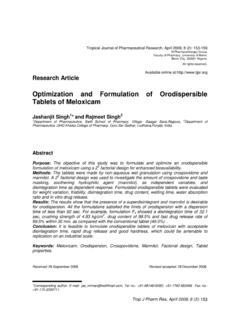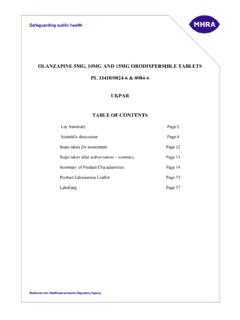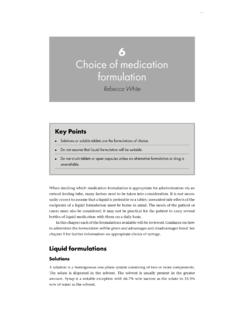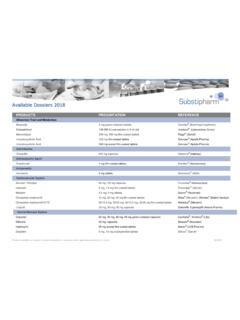Transcription of New Zealand Datasheet 1 PRODUCT NAME Ondansetron …
1 New Zealand Datasheet Name of Medicine Ondansetron -DRLA tablets Ondansetron ODT-DRLA tablets Ondansetron hydrochloride dihydrate tablets 4 mg and 8 mg Ondansetron 4 mg and 8 mg orodispersible tablets Presentation Ondansetron -DRLA tablets 4 mg: Light yellow, oval, biconvex film coated tablet embossed 'OND' on one side and '4' on the other. Each tablet contains Ondansetron 4 mg (as hydrochloride dihydrate). Ondansetron -DRLA tablets 8 mg: Dark yellow, oval, biconvex film coated tablet engraved 'OND' on one face and '8 on the other. Each tablet contains Ondansetron 8 mg (as hydrochloride dihydrate). Ondansetron ODT-DRLA orodispersible tablets 4 mg: White to off-white, biconvex, uncoated tablets embossed 4 on one side and O on the other side.
2 Each tablet contains Ondansetron 4 mg. Ondansetron ODT-DRLA orodispersible tablets 8 mg: White to off-white, biconvex, uncoated tablets embossed 8 on one side and O on the other side. Each tablet contains Ondansetron 8 mg. Do not halve the tablet. Dose equivalence when the tablet is divided has not been established. Uses Actions Ondansetron is a potent, highly selective 5HT3 receptor-antagonist. Its precise mode of action in the control of nausea and vomiting is not known. Chemotherapeutic agents and radiotherapy may cause release of 5HT in the small intestine initiating a vomiting reflex by activating vagal afferents via 5HT3 receptors. Ondansetron blocks the initiation of this reflex. Activation of vagal afferents may also cause a release of 5HT in the area postrema, located on the floor of the fourth ventricle, and this may also promote emesis through a central mechanism.
3 Thus, the effect of Ondansetron in the management of the nausea and vomiting induced by cytotoxic chemotherapy and radiotherapy is probably due to antagonism of 5HT3 receptors on neurons located both in the peripheral and central nervous system. The mechanisms of action in post-operative nausea and vomiting are not known but there may be common pathways with cytotoxic induced nausea and vomiting. Ondansetron does not alter plasma prolactin concentrations. Pharmacokinetic properties Following oral administration, Ondansetron is passively and completely absorbed from the gastrointestinal tract and undergoes first pass metabolism. Peak plasma concentrations are attained approximately hours after dosing.
4 For doses above 8 mg the increase in Ondansetron systemic exposure with dose is greater than proportional; this may reflect some reduction in first pass metabolism at higher oral doses. Bioavailability is slightly enhanced by the presence of food but unaffected by antacids. The disposition of Ondansetron following oral, intramuscular or intravenous dosing is similar with a terminal elimination half life of about 3 hours and steady state volume of distribution of about 140L. Ondansetron is not highly protein bound (70-76%). Ondansetron is cleared from the systemicirculation predominantly by hepatic metabolism through multiple enzymatic pathways. Less than 5% of the absorbed dose is excreted unchanged in the urine.
5 The absence of the enzyme CYP2D6 (the debrisoquine polymorphism) has no effect on Ondansetron 's pharmacokinetics. The pharmacokinetic properties of Ondansetron are unchanged on repeat dosing. Studies in healthy elderly volunteers have shown slight, but clinically insignificant, age-related increases in both oral bioavailability and half-life of Ondansetron . Gender differences were shown in the disposition of Ondansetron , with females having a greater rate and extent of absorption following an oral dose and reduced systemic clearance and volume of distribution (adjusted for weight). In a clinical study, 51 paediatric patients aged 1 to 24 months received either or mg/kg Ondansetron prior to undergoing surgery. Patients aged 1 to 4 months had a clearance when normalised to body weight that was approximately 30% slower than in patients aged 5 to 24 months but comparable to the patients aged 3 to 12 years.
6 The half-life in the 1 to 4 month patient population was reported to average hours compared to hours for patients in the 5 to 24 month and 3 to 12 year age range. No dose adjustment is necessary for patients aged 1 to 4 months as only a single dose of Ondansetron is recommended for the treatment of postoperative nausea and vomiting. The differences in pharmacokinetic parameters can be explained in part by the higher volume of distribution in the 1 to 4 month patient population. In a study of 21 paediatric patients aged between 3 and 12 years undergoing elective surgery with general anaesthesia, the absolute values for both the clearance and volume of distribution of Ondansetron following a single intravenous dose of 2 mg (3-7 years old or 4 mg (8-12 years old) were reduced in comparison to values with adult patients.)
7 Both parameters increased in a linear fashion with weight and by 12 years of age, the values were approaching those of young adults. When clearance and volume of distribution values were normalised by body weight, the values for these parameters were similar between the different age group populations. Use of weight-based dosing ( mg/kg up to 4 mg maximum) compensates for these changes and is effective in normalising systemic exposure in paediatric patients. Population pharmacokinetic analysis was performed on 74 patients aged 6 to 48 months following administration of mg/kg Ondansetron every 4 hours for three doses for the treatment of chemotherapy induced nausea and vomiting and 41 surgery patients aged 1 to 24 months following administration of a single mg/kg or mg/kg dose of Ondansetron .
8 Based on the population pharmacokinetic parameters for subjects aged 1 month to 48 months, administration of a mg/kg dose of Ondansetron every 4 hours for 3 doses would result in a systemic exposure (AUC) comparable to that observed in paediatric surgery subjects aged 5 to 24 months and previous paediatric studies in cancer (aged 4 to 18 years) and surgical (aged 3 to 12 years) subjects, at similar doses. In patients with moderate renal impairment (creatinine clearance 15-60 ml/min), both systemic clearance and volume of distribution are reduced, resulting in a slight, but clinically insignificant, increase in elimination half-life ( ). A study in patients with severe renal impairment who required regular haemodialysis (studied between dialyses) showed Ondansetron 's pharmacokinetics to be essentially unchanged.
9 In patients with severe hepatic impairment, Ondansetron 's systemic clearance is markedly reduced with prolonged elimination half-lives (15-32h) and an oral bioavailability approaching 100% due to reduced pre-systemic metabolism. Indications Ondansetron -DRLA tablets and Ondansetron ODT-DRLA tablets are indicated for the management of nausea and vomiting induced by cytotoxic chemotherapy and radiotherapy. Ondansetron -DRLA tablets and Ondansetron ODT-DRLA tablets are also indicated for the prevention of post-operative nausea and vomiting. Dosage and Administration Ondansetron is also available for parenteral use to allow the route of administration and dosing to be flexible. Place the Ondansetron ODT-DRLA orodispersible tablet on top of the tongue, where it will disperse within seconds, then swallow.
10 The film coated tablets can be taken with a drink of water. Do not halve the tablet. Dose equivalence when the tablet is divided has not been established. Chemotherapy and radiotherapy induced nausea and vomiting Adults The emetogenic potential of cancer treatment varies according to the doses and combinations of chemotherapy and radiotherapy regimens used. Emetogenic Chemotherapy and Radiotherapy: The recommended oral dose is 8 mg 1-2 hours before treatment, followed by 8 mg orally 12 hours later. To protect against delayed or prolonged emesis after the first 24 hours, oral treatment with Ondansetron -DRLA tablets or Ondansetron ODT-DRLA tablets should be continued for up to 5 days after a course of treatment.
















